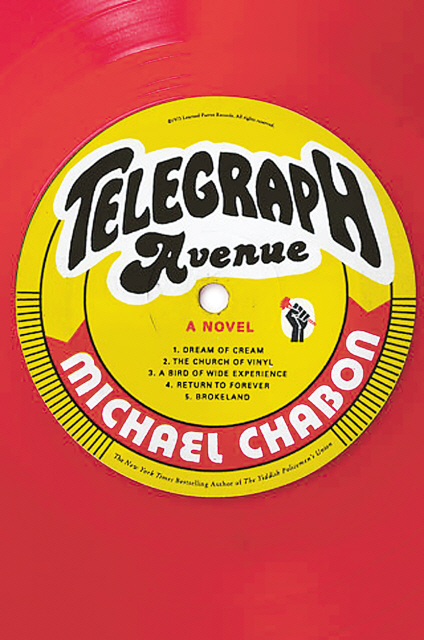
By Michael Chabon
(Harper)
One of the great boundary-defying outlaws of contemporary American fiction, Michael Chabon revels in high culture and low. He’s as likely to write about comic books (“The Amazing Adventures of Kavalier & Clay”) as the mysteries and snares of the literary life (“Wonder Boys”). He has written a Harry-Potteresque novel for young readers (“Summerland”) and a grown-up detective tale (“The Yiddish Policemen’s Union”). Whatever the subject or genre, the language always soars.
Now comes another audacious novel rooted in pop culture and expressed in delicious American vernacular. Although “Telegraph Avenue” is set early in our century, on Oakland’s main drag near Berkeley, it speaks in the brassy, in-your-face 1970s funkadelic of its protagonists. Archy Stallings and Nat Jaffe ― one black, the other white_are best friends and proprietors of a used-record shop on the avenue. Brokeland specializes in that era’s R & B and soul jazz when these men were young and carefree.
Now their cozy neighborhood gathering place is threatened by a huge mall, bankrolled by Gibson Goode, a onetime star pro quarterback who’s the Fifth Richest Black Man in America. Archy’s wife, Gwen, and Nat’s wife, Aviva, have a fragile partnership of their own; they are midwives in a world wishing to relegate them to a pre-scientific past.
Like business behemoths dealing with mom-and-pop stores, fathers have a way of obliterating sons. But when Titus, Archy’s long-lost teenage son by another relationship, shows up in town, befriending Nat and Aviva’s 14-year-old son, Julius, it’s Archy who’s at sea. He’s still reeling from a kung-fu champion father, Luther, who starred in blaxploitation movies while abandoning him. Now Luther, down-and-out but still feisty, has turned up, too.
“Telegraph Avenue” riffs wisely on fathers and sons, husbands and wives, gays and straights (the two teens are just barely in the closet), but it focuses primarily on race and music, especially the impact of black culture on the white mainstream. In this universe_Archy calls it “Africa and Europe cooked up in the same skillet” ― style is king. And Chabon proves himself a master of swagger.
Here’s his take on a body-shop owner: “Mustached face made out of orange rocks seamed together like the Thing in the Fantastic Four, slung wide as the cars by which he got his living, thick white hair streamlined into a swan, the fin on some heap of the Fonzie years.”
A woman hurrying to avoid a confrontation bears “the cool skedaddle of a shoplifter making for the door.”
All this sometimes proves too much of a good thing, but the style unquestionably serves the story and its characters. A reader can’t help falling for them as they struggle for dignity in an unforgiving world. Chabon not only knows how they feel but how they talk. His dialogue is a thing to behold, the plot unrelenting. And I can’t imagine any writer, male or female, ever delivering a more breathtaking description of a woman giving birth. Some midwife, this Chabon. (MCT)











![[Weekender] Pet food makers bet big on ‘recession-free’ pet food market](http://res.heraldm.com/phpwas/restmb_idxmake.php?idx=644&simg=/content/image/2024/05/10/20240510050754_0.jpg&u=20240511163252)

![[Weekender] Pet food makers bet big on ‘recession-free’ pet food market](http://res.heraldm.com/phpwas/restmb_idxmake.php?idx=652&simg=/content/image/2024/05/10/20240510050754_0.jpg&u=20240511163252)




![[What to play] Musical tributes to family in the month of family](http://res.heraldm.com/phpwas/restmb_idxmake.php?idx=642&simg=/content/image/2024/05/09/20240509050795_0.jpg&u=)